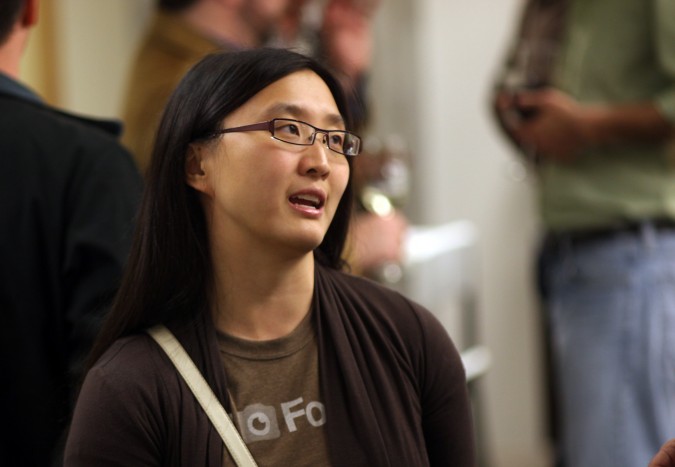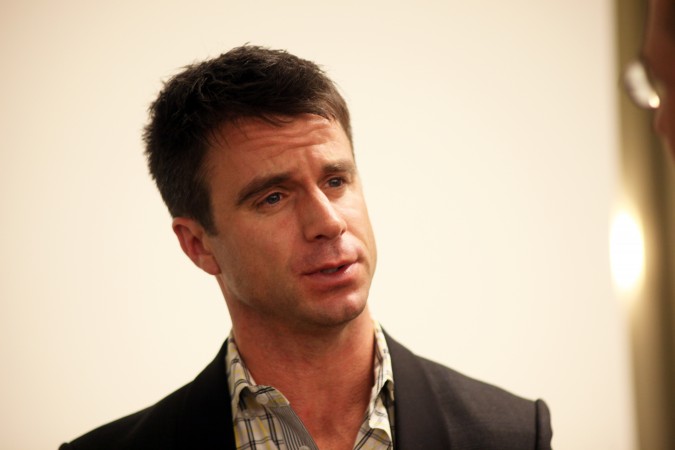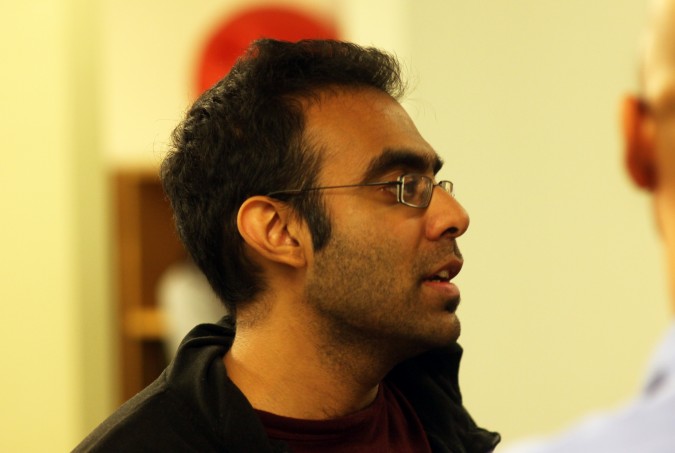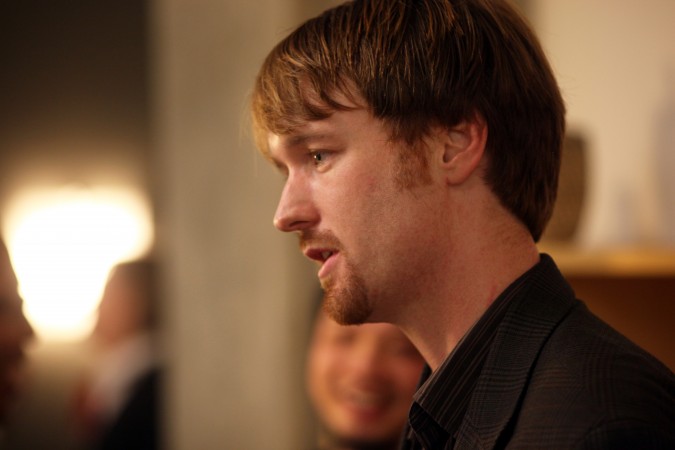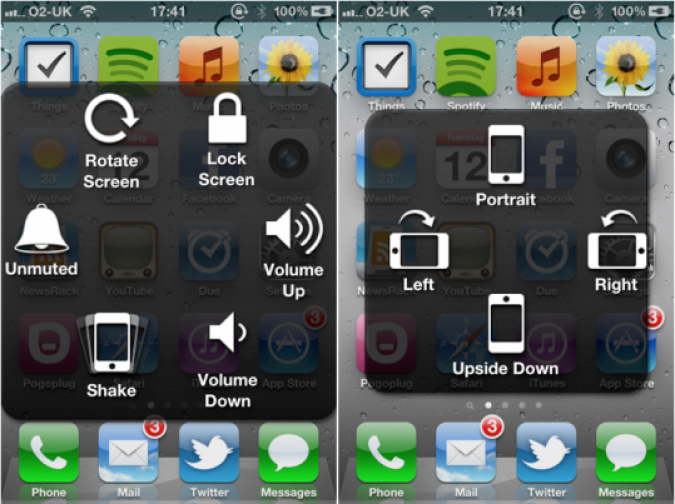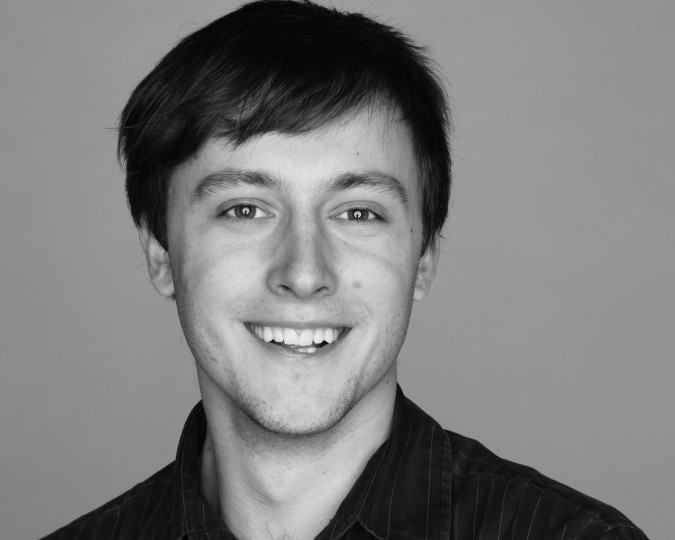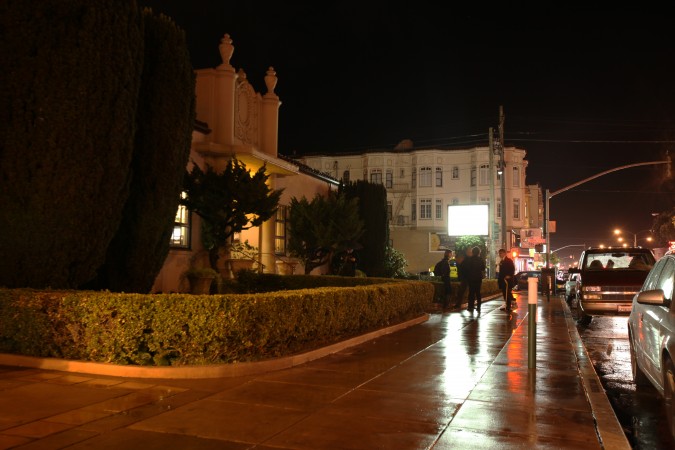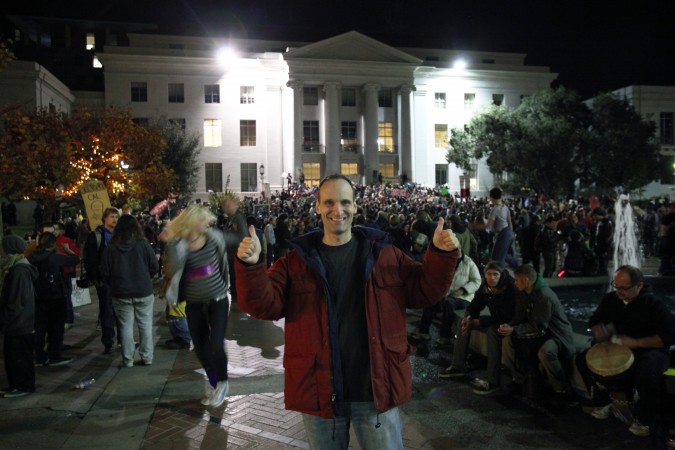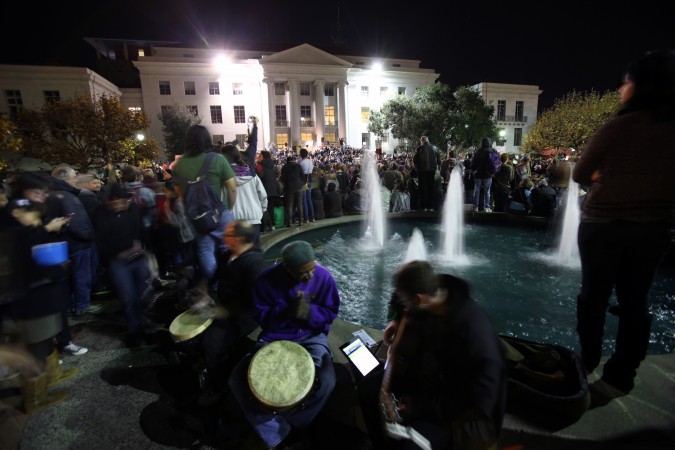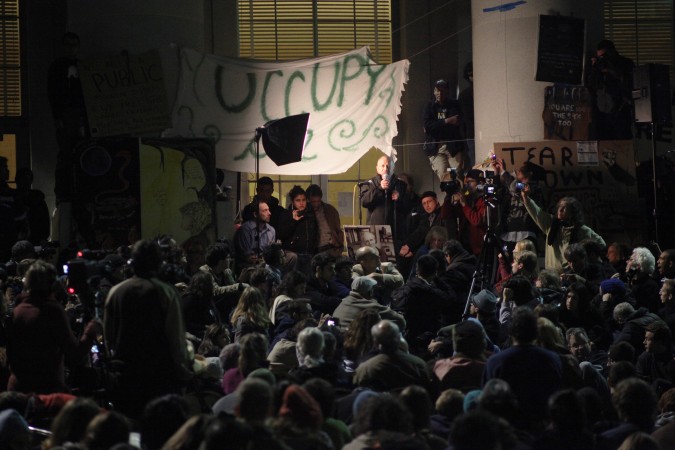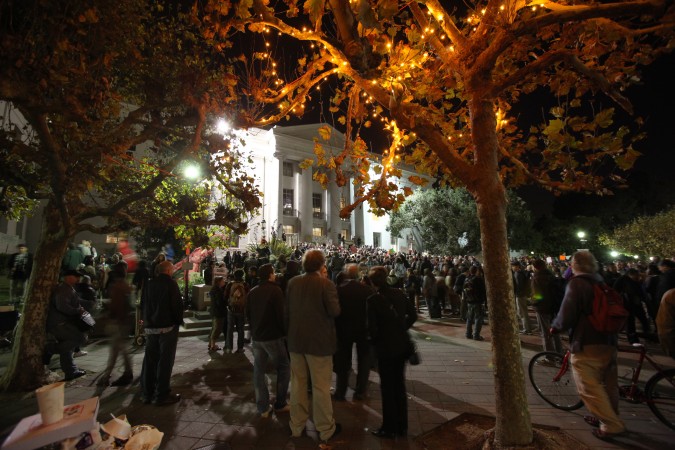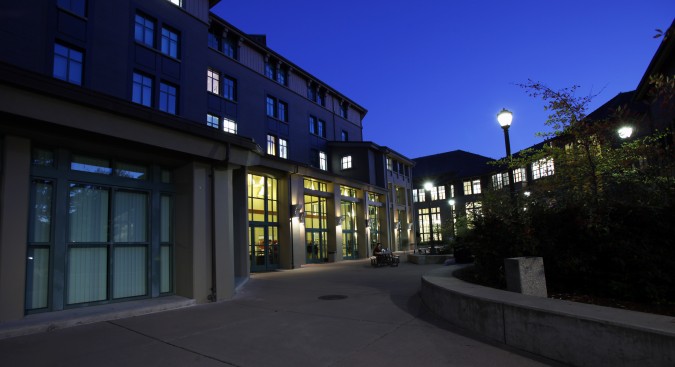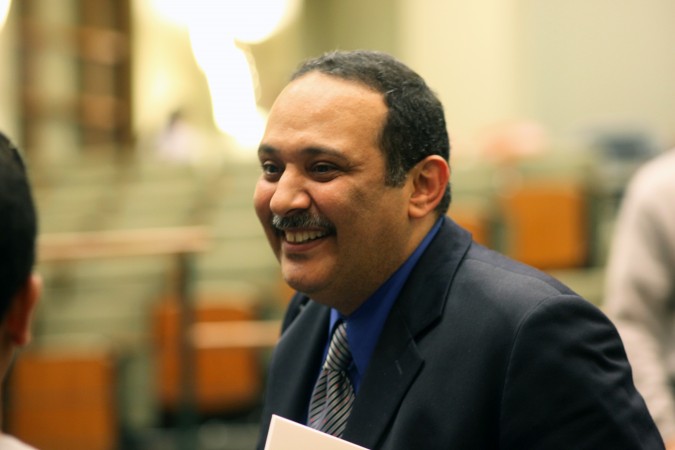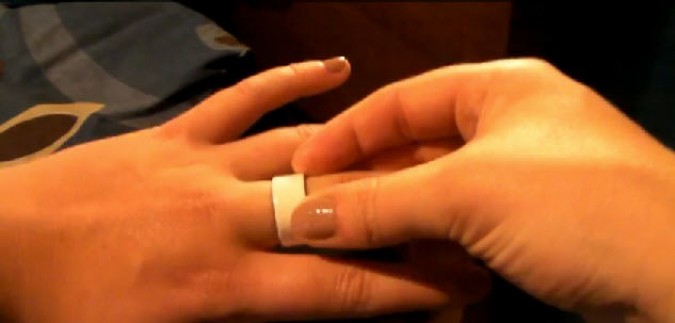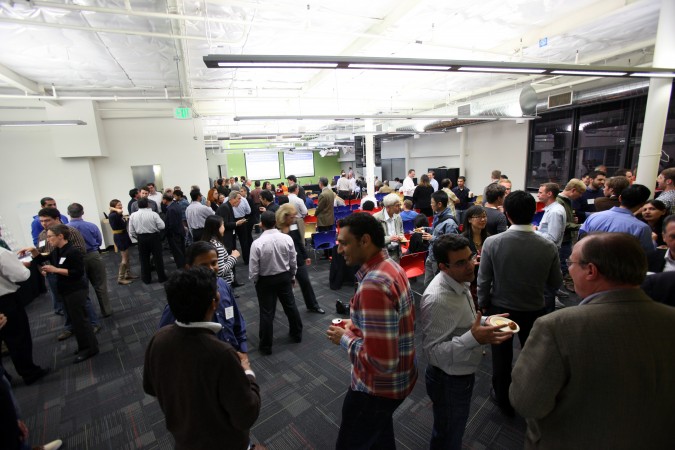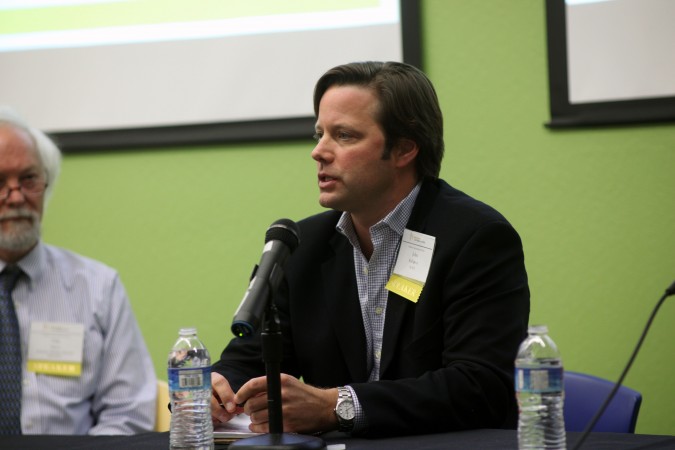Archive for 2011
Food Startups panel discussion at SOMA Central in San Francisco
On Wednesday, November 16, 2011 I attended a fascinating panel discussion entitled Food Startups. To learn more about Food Startups, follow @foodstartups on Twitter.
The panelists were:
- Rob LaFave, Founder and CEO of Foodzie
- Nikhil Arora, Founder of Back to the Roots
- Alexa Andrzejewski, Founder and CEO of Foodspotting
- Rajat Suri, Founder and CEO of E la Carte
- Nate Gallon, Partner at Wilson Sonsini Goodrich & Rosati, PC
- Ananda Neil, Founder of Artisan Growers and Producers
The moderator was Wade Roush, Chief Correspondent at Xconomy and Editor of Xconomy San Francisco.
Food Startups was organized by my friend Matthew Wise, who invited me. Wise is a busy man — he’s running two startups — FounderLY and TableSlice.
Wade Roush was the moderator.
Wade Roush was a staff member at MIT’s Technology Review (a very good magazine my father gave me a subscription to for my birthday on October 6th), serving multiple roles, including senior editor, San Francisco bureau chief and executive editor of the magazine’s TechnologyReview online presence. Roush was also the Boston bureau reporter for Science magazine and managing editor of supercomputer publications at NASA Ames Research Center. Roush graduated with honors in the history of science from Harvard University and earned a PhD in the history of science and technology from MIT.
Wise gathered a panel that is the equal of panels I’ve seen at the MIT Venture Lab series held at Stanford University. In other words, simply outstanding.
I captured the entire panel discussion to video, and I have embedded it here.

Nate Gallon, partner at Wilson Sonsini Goodrich & Rosati, and Matthew Wise, Food Startups organizer, November 16, 2011
Since the video is available, I will reserve my written remarks for the most entertaining highlights of the evening.
The most remarkable startup story was that of Nikhil Arora. Arora founded a food company that is brilliant. It’s called Back to the Roots. Their product is mostly recycled trash I presume they either get for free or are paid to take away. Sounds unappealing you say? It’s not. Back to the Roots gathers tons and tons of used coffee grounds from San Francisco Bay Area coffee shops and resells the grounds to consumers for about USD $8.00 a pound.
That’s not much less than the coffee cost before it was earlier flooded with hot water to make coffee.
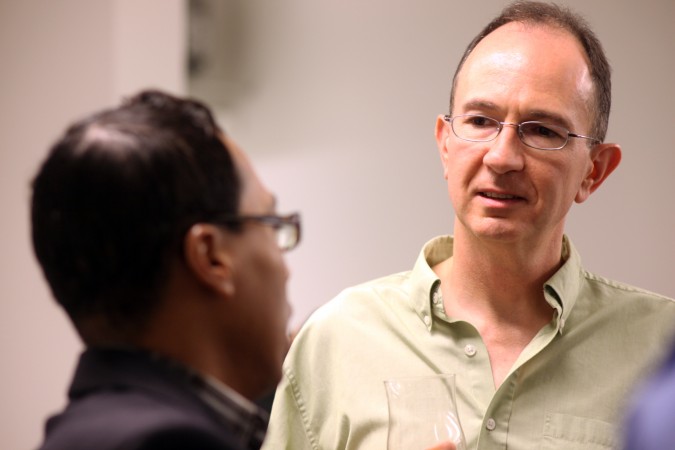
Matthew Wise, Food Startups organizer, and Wade Roush, Chief Correspondent at Xconomy and Editor of Xconomy San Francisco. November 16, 2011.
The secret sauce is that Back to the Roots adds mycelia to the coffee grounds and then boxes up what others consider trash in attractive boxes that when opened form the container for the buyer’s mini mushroom farm.
The farm is started by opening the box and misting the grounds with water from a tiny 1 ounce spray bottle that’s included with the kit. After misting twice a day for 10 days, the first harvest is ready, and one box can be harvested multiple times until a pound and a half of oyster mushrooms have been picked. Then the unbleached cardboard box and the grounds can be recycled. Genius.
The founder is a Haas School of Business graduate that knew nothing about the food business when he started in 2009. His company now operates a 10,000 square foot warehouse and his mushroom growing kits are for sale at Whole Foods Markets and Home Depot. Those are two customers not frequently paired in the same sentence.
Arora had the approximately 50 people in attendance enthralled when he described an early sales visit to a Whole Foods Market grocery store. Without an appointment, he brought in a plastic bucket of used coffee grounds and somehow captured the attention of the rank-and-file worker (whoops… associate) he first walked up to. He was ushered in to meet with a manager and an order flowed from that bold move. I found it to be an inspiring and moving story.
This Food Startups event was sponsored by:
- Artisan Growers and Producers
- Six Finger Films
- Tony Chen Productions
- FounderLY
The stories of the other panelists were fascinating as well. Please watch the video. I’m sorry I don’t have the time to write detailed summaries of the other fine and worthy companies.
Entrepreneurs are rewarded for being bold and outrageous.
Read about Justin Yoshimura of 500friends for another example.
Here’s what Steve Newcomb of Founder School says about Yoshimura:
“I thought I had met some tenacious people in my life, but Justin is ridiculous. In some super weird, proud way, he reminds of some little mangy dog that bites your leg and just won’t let go. If Justin decides he’s going to do something, he’s going to do it, no matter how scrappy he needs to be to get the job done. Keep going you scrappy little dog… make us proud.”
Another bold and outrageous entrepreneur sadly passed away recently, and this seems a fine place to focus additional attention on his remarkable life.
Andreas (Andy) Sæbjørnsen is the co-founder of the two startups Matthew Wise is working on, FounderLY and TableSlice.
I took all the pictures and video for this and posted the pictures at full 21 megapixel resolution. Click on the pictures to see the full size versions.
While I was researching Nikhil Arora for this post, I discovered his TEDx appearance where he talks about his urban mushroom farming enterprise Back to the Roots. I embed the video of the talk below, since I think it’s worth watching. Enjoy.
If you enjoy my posts, please share them on Facebook or Twitter. Also, please consider subscribing by filling in your email address in the box in the upper right corner of this page.If you want to use the pictures from this site, I’ll probably let you, so just ask.
Additionally, I want to become a public speaker and guest columnist. If you have an opportunity to offer for either, I’d love to hear from you. You can find me on Facebook and Twitter.
Finally, please leave a comment and friend me on Facebook if what I write resonates with you. Thanks!
University of California at Davis Assistant Professor calls for Chancellor Linda P.B. Katehi to resign

UC Davis police officer pepper sprays student protesters, November 18, 2011. Photograph by Wayne Tilcock of The Davis Enterprise.
I hope this letter doesn’t spell the end of Nathan Brown’s career and/or prevent him from being granted tenure.
Brown cites the November 18, 2011 pepper spraying of University of California at Davis students that had set up tents to protest as part of the Occupy Wall Street movement. Brown calls for Chancellor Katehi to immediately resign. He doesn’t soften his words. He concludes:
“I call for your resignation because you are unfit to do your job. You are unfit to ensure the safety of students at UC Davis. In fact: you are the primary threat to the safety of students at UC Davis. As such, I call upon you to resign immediately.”
Yes, he called the Chancellor the primary threat to the safety of students at UC Davis.
I am proud of Nathan Brown, and I wish him well. I would take a class from him, for I suspect he’s an outstanding and conscientious educator. His friends, family and students should be proud.
Thank you to my friend Danae Sterental for bringing this powerful letter to my attention.
Assistive Touch for iOS5 Apple operating system for mobile devices
David Pogue, the Walt Mossberg of The New York Times newspaper taught me something today. Apple’s iOS 5 mobile operating system incorporates extensive usability features for the disabled.
Pogue writes:
“One new feature, called AssistiveTouch, is Apple’s accessibility team at its most creative. When you turn on this feature in Settings->General->Accessibility, a new, white circle appears at the bottom of the screen. It stays there all the time.
When you tap it, you get a floating on-screen palette. Its buttons trigger motions and gestures on the iPhone screen without requiring hand or multiple-finger movement. All you have to be able to do is tap with a single finger — even a stylus you’re holding in your teeth or fist.
For example, you can tap the Home on-screen button instead of pressing the physical Home button.
If you tap Device, you get a sub-palette of six functions that would otherwise require you to grasp the phone or push its tiny physical buttons. There’s Rotate Screen (tap this instead of turning the phone 90 degrees), Lock Screen (tap instead of pressing the Sleep switch), Volume Up and Volume Down (tap instead of pressing the volume keys), Shake (does the same as shaking the phone to undo typing), and Mute/Unmute (tap instead of flipping the small Mute switch on the side).”
I think Apple deserves a round of applause for anticipating the needs of its users with disabilities.
I think David Pogue also deserves a round of applause, for bringing these features to the attention of a wide audience. These features have been written about earlier, but I didn’t learn about them until today.
Thankfully, I am not disabled, but I have considered the plight of those who are disabled, since Purple Communications, the company I sold my last startup to, caters exclusively to the disabled market. I still follow Purple, and I hope Apple doesn’t eventually drive them out of business by including features helpful to the disabled at no extra cost. Purple employs upwards of 1,000 people to help the deaf and hearing communicate by both wired and wireless devices.
Here’s a video that shows the feature in action. I found this on YouTube.
As a side note, I am a fan of David Pogue because he wrote in his first iPhone Missing Manual book about the very simple word processor my company used to offer for iPhone, launched 7/7/07. Thank you David!
Memorial service for Ilya Zhitomirskiy, co-founder of the start-up social network Diaspora*
Tonight I attended a public memorial service in San Francisco, California USA for Ilya Zhitomirskiy, co-founder of the start-up social network Diaspora*. The service was held at McAvoy O’Hara mortuary at 4545 Geary Boulevard. I took the picture below of McAvoy O’Hara as I was departing.
Ilya Zhitomirskiy died Saturday, November 12, 2011 at his home in San Francisco. The preceding link is to his lengthy obituary in the New York Times newspaper, a testamant to Zhitomirskiy’s influence. Such coverage is remarkable for someone whose idea that made them famous has not officially launched yet. Such coverage is remarkable for someone just 22 years old at their passing.
I met Zhitomirskiy only once, and I don’t remember the meeting except in the vaguest sense. My friend Matthew Wise introduced me to Zhitomirskiy at an office warming party for CloudFlare, which I wrote about here at the time. Wise reminded me two days ago at his Foods Startup event that he had introduced me. I recall that Wise had mentioned Diaspora* at the CloudFlare party. I had heard of Diaspora* back then, but I didn’t appreciate the significance of meeting one of the co-founders because I wasn’t aware how much attention the project had already garnered.
With that introduction you might wonder why I went to the man’s memorial service. On a group hike some weeks back I had a long and interesting conversation with Bobby Fishkin. Fishkin was a good friend of Zhitomirskiy, and yesterday Fishkin sent out a broadcast email to his connections inviting them to attend Zhitomirskiy’s memorial, which was described as ‘open to all.’ Fishkin can write a moving email, and his text was so descriptive and colorful that I decided to attend. In part, Fishkin wrote:
“He was a visionary and revolutionary. He approached the world out of love and then used a profoundly gifted analytical mind to approach what could be done based on that love to circumvent all the forces of the world that would otherwise get between us and those we love. He founded Diaspora to achieve this. But more than this, he sought solutions to global challenges and gave us all further confidence to speak our truth.”
How could I not attend the memorial after an introduction so uplifting?
I am glad that I did attend, as this was the most moving and thought provoking memorial I have yet attended.
It made me cry many times and I wasn’t even Zhitomirskiy’s friend.
Over 100 of Zhitomirskiy’s friends were in the room, and I estimate 20 of them came to the podium to share their memories. I feel like I learned the essence of who Ilya Zhitomirskiy was in the course of this memorial. I wish I had gotten to know him better, as he seemed like a remarkable thinker.
A recurring theme his friends recounted was that Zhitomirskiy kept extensive to-do lists on Post-It notes on how to change and improve the world. He collected these notes on one of those skewers pointing in the air that restaurants stick their filled receipts upon. These notes and lists apparantly are so profound that one of his friends collected them and made a website dedicated to just displaying Zhitomirskiy’s to-do lists.
Zhitomirskiy talked of slaying metaphorical dragons frequently, I learned.
He dreamed of traveling the world as a public speaker, and longed for a way to have such travel and talking paid for. I have that in common with him…
He talked too much, but in a way that mesmerized his friends. One of his most ardent friends, Elizabeth Stark (I didn’t learn her last name, and it seemed the wrong place to ask), an instructor at Stanford University, described passionately how she could stay up until 5am talking with Zhitomirskiy, and that such conversations seemed to just fly by they were so engrossing. I got the distinct impression that Elizabeth is a very smart woman, and she looked to be 10 years older than Zhitomirskiy. He must have been quite an impressive guy to keep her attention until nearly sunrise.
His friends over and over promised Zhitomirskiy that they would work hard in life to help finish his to-do list. They said Zhitomirskiy lived by a code where he advised keeping good company and making outrageous demands of them. He was known for his epic (sic) parties, and for his intense drive to introduce people to each other at said parties. He even started a website themed around these parties, but I couldn’t find a working site at the domain name mentioned, epicparty.com or epicparties.com.
Zhitomirskiy’s passing brought so many of those in attendance to tears. They clearly and dramatically loved him. His friends and family I hope will take tremendous comfort that Ilya Zhitomirskiy so profoundly touched so many impressive people. The whole room seemed to be filled with impressive and thoughtful people. One Asian woman who spoke at the podium had only known Zhitomirskiy for a month, yet her remarks were insightful and lovely. I meant to tell her so after, but she was engrossed in a conversation and I didn’t want to interrupt her.
It’s so sad when a bright light goes out too soon. I reflect on my own life at times like these. I pledge to redouble my efforts to help others and bring more happiness and good to the world. Thank you Ilya Zhitomirskiy for the inspiration you gave me to write about you and reflect on your short yet meaningful life.
I predict your influence Ilya Zhitomirskiy will remain upon the globe for many moons. May you rest in peace.
PS – I particularly invite Zhitomirskiy’s friends to introduce themselves to me by sending me a message or friending me on Facebook here. I’d like to learn more about your friend, and I’d like to know you as well, as it appears he kept quite good company from what I saw this evening.
[Additional: I added this November 24, 2011. After I wrote the above post, a friend of mine sent me a picture taken March 3, 2011. The picture is from the CloudFlare party I mention above, and it shows me with Ilya and four others. It’s a great picture, so I posted it to my blog here.]
[Additional: I added this February 9, 2012. I added the last name of Elizabeth to this post, as I found out her last name.]
Intel Capital Global Summit 2011 concluded yesterday
This week Intel Capital held its Global Summit for its Portfolio Companies. This event used to be called the Intel Capital CEO Summit, and I attended in 2008 and 2009 since my company Silveroffice, Inc. is an Intel Capital Portfolio Company. I did not attend this year because only select Portfolio Companies are invited, and I was not invited this year.
I am not upset or complaining however! Frankly, Silveroffice doesn’t deserve an invitation this year because it has been mostly dormant while I work on other projects in life.
I have committed to making Silveroffice a success, and I’m working on it strenuously again, for the first time in years. I have a renewed vision and passion for the company, one that will involve a complete rewrite of the software on a new platform. I am firing on all cylinders again after taking my foot off the accelerator for an extended period of deceleration.
I feel outstanding.
I remain in touch with people from Intel Capital, and perhaps one day I’ll be invited back to their Global Summit. But even if I’m not, I’ll fondly remember the fun I had at past events. In 2008 Intel Capital took over The Tonga Room restaurant at San Francisco’s Fairmont Hotel for breakfast, so I’ve eaten breakfast by The Tonga Room tropical lake, an unforgettable experience.
I got to meet and have several real conversations with musician and tech entrepreneur MC Hammer, in 2008 and 2009. In 2009 he remembered me from 2008. I’m certain of it because in 2009 I introduced my friend Gail Kantor, CEO of eJamming, also a Portfolio Company, to Hammer. Hammer looked at both of us and pointed at Kantor and said “You I haven’t met” and amazingly then pointed at me and said “You I have met.’ I only spoke with Hammer for perhaps 10 minutes the previous year, and we didn’t stay in touch, not even via social media. Hammer must meet thousands of people a year, and to be able to accurately remember me a year later after talking with me for such a short time was simply jaw dropping.
I recognize many tech entrepreneurs have met Hammer because he’s reputed to be a fixture at Silicon Valley events. But still it was fun to meet a real rock star and have dinner with him like I did in 2009.
I feel I let Intel Capital down by taking my foot off the Silveroffice, Inc. accelerator. They reached out to me to invite me to become a Portfolio Company. Part of my motivation to rebuild Silveroffice and make it a meaningful company again is to prove to Intel Capital that they did not misplace their confidence in me. This might seem like a silly reason, but I carefully debated accepting Intel Capital’s offer, and the negotiation of our deal took roughly a year to complete, so I have something invested, as do they. I started Silveroffice in 2003 so it is deeply a part of my life, and I enjoy working on it. Great things are to come, so stay tuned.
Silveroffice, Inc. doesn’t have a website, which is why the references above are not hyperlinks. Silveroffice created the first true online office suite, way back in 2004. It’s called gOffice. gOffice has been decimated in the marketplace by Google Apps and Zoho, but gOffice was number one in the world for over a year. If only some nice person would write a WikipediA entry for gOffice, I would be so pleased…
If you write a WikipediA entry, don’t overlook that Microsoft lists gOffice by name in its 10K Annual Report as a competitor to Microsoft Office from 2006 through 2010. In 2011 Microsoft stopped naming in its annual report any of its online competitors to Microsoft Office, so that’s why gOffice doesn’t appear in their 2011 report.
Occupy Cal protest at University of California at Berkeley November 15, 2011
I was at the Occupy Cal protest at University of California at Berkeley last evening, November 15, 2011. There were over 1,000 protesters there. The energy in the air was positive and infectious.
As far as I could detect, the Occupy Cal event wasn’t marred by the shooting of a Berkeley student by campus police earlier in the afternoon. That student later died at the hospital. That student, Christopher Nathen Elliot Travis, age 32, was a transfer student from Ohlone College in Fremont, California.
Haas School of Business Dean Richard Lyons addressed the school’s students this morning. Later, Lyons posted this letter to the Haas Newsroom and publicized it via the micro-blogging website Twitter.
My friend Heather Sepulveda went to Ohlone College before she transferred to UC Berkeley years ago — a very strange coincidence to be sure.
There was a drum beat to the protest, thanks to the talented musicians that showed up. One of the musicians looked to be about 60, and he said he had participated in the anti war protests at UC Berkeley in the 1960s. I feature some of the music in the video I am editing from the event, which I hope to post tomorrow. I got some great video, including of the camping tents being carried into place.
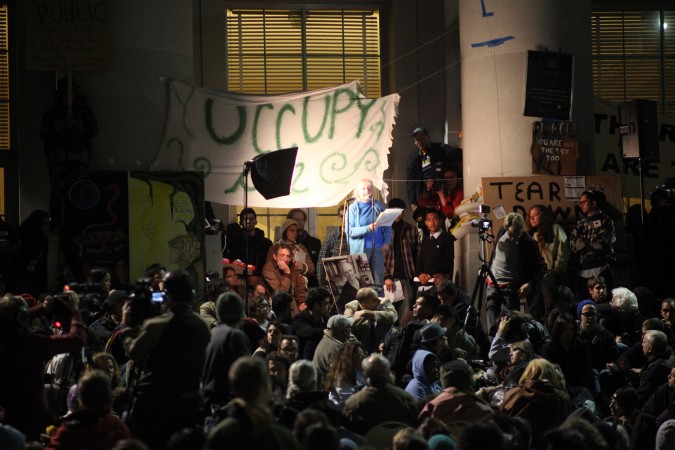
Board member of the Mario Savio Lecture Fund addressing Occupy Cal protesters November 15, 2011 at Sproul Plaza
The event incorporated a gathering of The Savio Lecture Fund, which originally was to take place indoors at the Pauley Ballroom in the Martin Luther King Jr. Student Center, also on the UC Berkeley campus. My guess is the change of venue was decided close to the last minute to benefit from the association with the Occupy Cal movement. I was not previously familiar with Mario Savio, I am embarrassed to admit. I concluded from the talks I heard last night that Savio would have embraced the Occupy Cal movement and message. Savio spoke on December 2, 1964 from the same steps of Sproul Hall where the speakers last night spoke from.
The Savio Lecture speaker last evening was former United States Secretary of Labor Robert Reich, who is a Professor of Public Policy at UC Berkeley. I captured his speech to high definition video and presented it on my blog earlier today.
In the photograph above you can see some of the camping tents already in place, along with another tent being carried into place already set up. Organizers were distributing hot food on the Sproul Hall steps. Even though there were a lot of people there, it was possible to easily move among the crowd, and I had no trouble taking pictures and video, even though I had brought a tripod with me, for many of the time exposures I took to capture the low light images you see here.
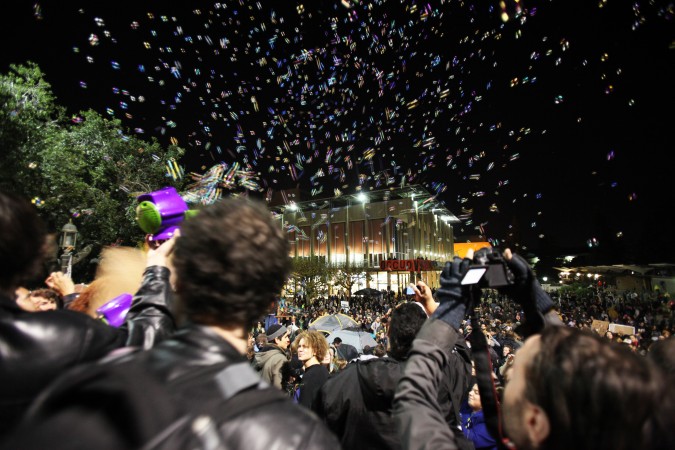
Soap bubbles by the hundreds liven up the view from the steps of Sproul Hall during Occupy Cal protest at UC Berkeley November 15, 2011
I took the above shot right before I departed, after 10pm. The group front and center appeared to be in their 50s and 60s. The age mix of the crowd was inspiring — it definitely wasn’t just current students in their teens and twenties. I felt that people were really passionate about the Occupy movement, and that this movement will be long lived and will accomplish real change in the world. I am glad I made the trip from San Francisco.
I uploaded these pictures at full 21 megapixel resolution. To see them at full size, click on them twice, with a pause in between the clicks to allow the photographs to load in a separate window. If you’d like to use these pictures for something, please give me a link back to my blog. If you like this blog, please subscribe, and please add this post to your status feed on Facebook. Thank you!
Robert Reich – Class Warfare in America, presented by The Mario Savio Memorial Lecture series at Occupy Cal, November 15, 2011
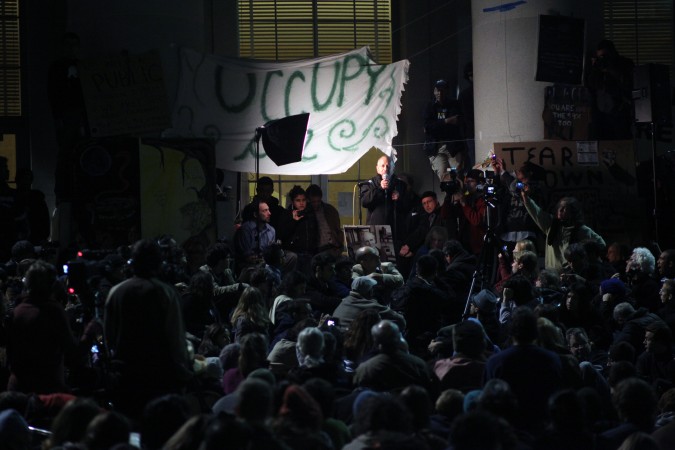
Robert Reich delivering speech 'Class Warfare in America' on Sproul Hall steps at UC Berkeley during Occupy CAL protest on November 15, 2011
I attended the Occupy Cal protest at University of California at Berkeley last evening, November 15, 2011. There were over 1,000 protesters there, including many approaching retirement age that indicated by a show of hands that they had earlier been there protesting in the 1960s and 1970s. It was an electrifying event that I will cover in detail in another blog post.
The event was made more thrilling by a speech given by Robert Reich, a professor of public policy at Cal. Cal is an abbreviation for University of California at Berkeley, for my readers unfamiliar with the word. The definition of Cal is well known locally, but on the world stage UC Berkeley is better known.
Reich was United States Secretary of Labor under President Bill Clinton. Reich is also a frequent commentator on NPR (formerly National Public Radio) in the United States. NPR is my favorite radio station, and I’ve heard Reich speak many times on the air. Last night was the first time I’ve seen him speak.
I brought my tripod and set up my Canon 5D Mark II camera with two of the legs touching one of the Occupy Cal camping tents that had earlier been set up before the steps of Sproul Hall at Sproul Plaza. This was a fantastic vantage point because the tent was already blocking the view of those sitting behind it, so my tripod didn’t appreciably further block the view. I simply sat on the pavement while the camera recorded. I recorded the full speech, and you can watch it in the video below. This is a compressed upload, but I have the full 7 gigabyte file in full HD. If you need the file for some project, please contact me.
Reich’s talk was very well received by the audience, including the tent dwellers sitting right next to me who graciously allowed me to set up there.
It was an inspiring and powerful speech. I am not going to try to summarize it since it’s brief and presented here in its entirety. I encourage you to watch it all the way through, and share it with your social network. I was so taken with it that I stayed up late into the morning editing and compressing the video so I could get this posted today during the day.
Intel Global Challenge 2011 at University of California at Berkeley
Yesterday evening, November 10, 2011, the 7th annual Intel Global Challenge final presentations were held in the Anderson Auditorium at the Haas School of Business on the University of California at Berkeley campus.
I took dozens of pictures, and I plan to write an extensive blog post later today. It’s 1:11 on 11/11/11 right now and I’m tired. But I’m posting a few highlights now to get something out. I’ll come back and fill out this post after I get some sleep.
Pillow talk re-imagined
Here’s a pair of gadgets that will warm your heart.
Romantic partners use Pillow Talk communication rings when they’re apart from each other overnight. The goal is to make the partners feel more tightly connected to each other.
Here’s the description from the inventor’s website:
Pillow Talk is a project aiming to connect long distance lovers. Each person has a pillow for their bed and a ring sensor which they wear to sleep at night. The sensor wirelessly communicates with the other person’s pillow; when one person goes to bed, their lover’s pillow begins to glow softly to indicate their presence. Placing your head on the pillow allows you to hear the real-time heartbeat of your loved one. The result is an intimate interaction between two lovers, regardless of the distance between them.
Reading about this product brought tears to my eyes it’s so simple and sweet. I wish I had thought of this. It’s a genuinely thoughtful use of technology to improve the human condition. Here’s the promotional video. Warning: you may cry when watching this! I did.
I have a big improvement for this pair of devices:
Make the pillows talk. After all, the product is called Pillow Talk, not Pillow Heartbeat.
Since voice consumes so little bandwidth, and Skype-to-Skype calls are free and may be of unlimited duration, I suggest the pillows be outfitted with speakers and microphones that stay on all night, so the other partner can hear the other breath. If the lovebirds want to talk, they can just start talking.
This ‘always on’ connectivity might take some getting used to, but I think such a system would for some become a must have product that they would miss terribly if it were taken away. The pull on the heart strings would be so powerful once a couple got used to ‘sleeping with their sweetie remotely’ that they wouldn’t want to give up the experience.
When I was a teenager, the father of one of my next door neighbors died without warning of a brain annurism. My mother was good friends with the mother whose husband had just died. My mother told me how much her friend told her that she missed hearing her husband snore. That story was so sad to me back then, and it still made me cry as I wrote this piece, years later. I was a teenager when this happened.
There is something so powerful about just sleeping beside your mate. It’s so intimate and irreplaceable and special.
A true pillow talk system with heartbeat, breathing and two way voice could be one Valentines ‘technology gift’ that would be loved by both men and women.
I recommend that such a product be initially built as a USB pillowcase that would plug into a power brick that plugs into the wall. Inside the brick would be a small computer running Linux plus a WiFi transceiver that would connect to the home or hotel’s WiFi connection. This way a computer would not need to be by the bed and batteries would not need to be charged. It would also keep the radio frequency part of the system away from the heads of the sleepers, probably a good thing since some people might use such a system for months or years at a time, particularly when you consider military personnel away from home for long periods of time.
If Apple starts making what I just described, they should call it iSleep! They could make an iPhone charging cord that splits off in two wires: one to the power brick and one to the pillow. An iPhone certainly has all the computing power necessary, and many people already sleep with their phones.
I have too many projects to do in life, so if you like this, build it and pay me the industry mean royalty for similar ideas. Let me know when it launches!
One more joke: This is a true peer to peer system! P2P or ‘pillow to pillow’ lol…
Berkeley Entrepreneurs Forum at Google, Inc. headquarters, October 27, 2011
Thursday October 27, 2011, I attended the first Berkeley Entrepreneurs Forum ever held away from the University of California at Berkeley campus.
The Forum was held in Building 40 at Google, Inc. headquarters in Mountain View, California USA. Getting to the event was a challenge because Google was throwing a huge celebration for the Indian national holiday Diwali. As a result, parking was tight and there were hundreds of people in the huge courtyard between the massive Google buildings. I’m not complaining for it was festive and an adventure. I photographed the 6,000 burning candles artfully arranged in the courtyard, as you can see at the bottom of this post. There was a live band. The Google cafeteria was packed. It was exciting.
The Entrepreneurs Forum was a small event compared to the outdoor Diwali celebration.
The title of the Forum was ‘Power Hungry: Developments in Energy-Efficiency Technologies for Data Centers.’ This was an appropriate event to have at Google, which I suspect runs the largest collection of computers in the world.
I learned a lot at this forum. For example, computer rooms that are chilly are computer rooms that are horribly inefficient. Modern servers can run fine at temperatures around 85F degrees, and sometimes even warmer. Here’s the official video, immediately above.
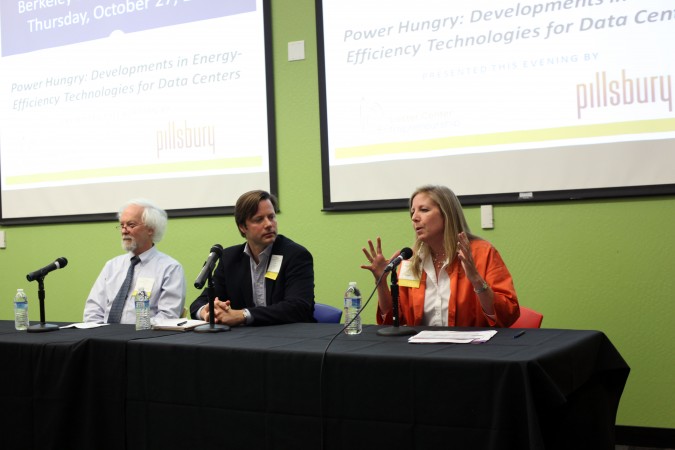
Dale Sartor, John Robison and Joyce Dickerson on panel at Berkeley Entrepreneurs Forum, October 27, 2011
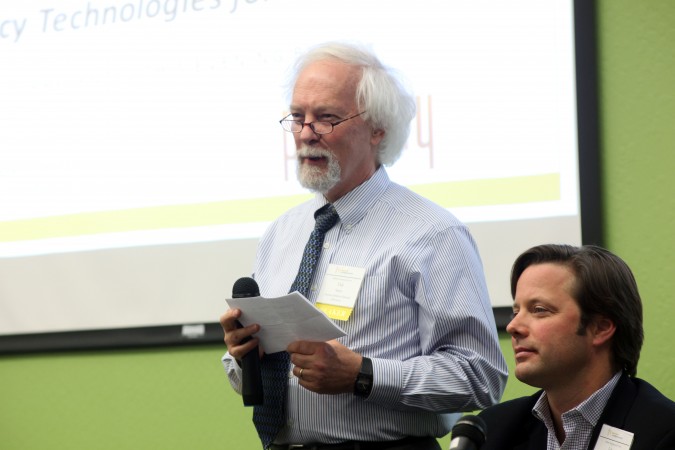
Dale Sartor, P.E., Applications Team - Environmental Energy Technologies Division, Lawrence Berkeley National Laboratory. Berkeley Entrepreneurs Forum, October 27, 2011

Joyce Dickerson, Sustainable IT at Stanford University, at Berkeley Entrepreneurs Forum, October 27, 2011

Sylvia Burks, Partner, Pillsbury Winthrop Shaw Pittman LLP, at Berkeley Entrepreneurs Forum, October 27, 2011
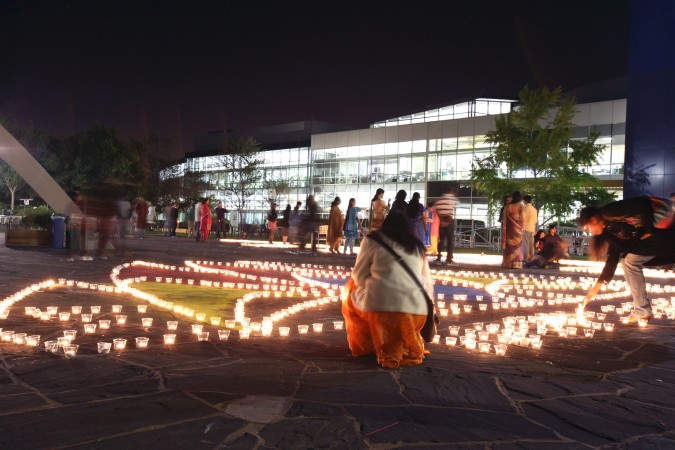
Diwali Festival of Lights with 6,000 candles at Google, Inc. headquarters in Mountain View, California, October 27, 2011. Photograph by Kevin Warnock.
[Note: I received a free pass to this event courtesy of my membership on the Advisory Council for the Berkeley Entrepreneurs Forum. I am writing here as a private citizen, not in any official capacity with UC Berkeley or the Berkeley Entrepreneurs Forum.]

